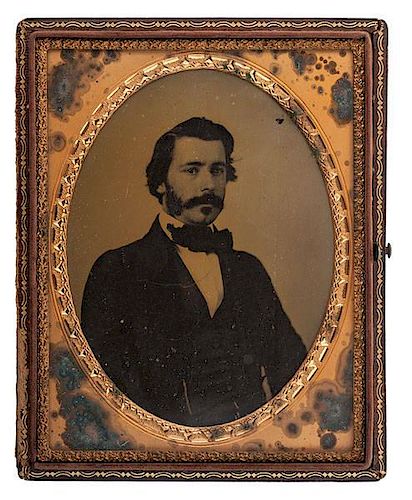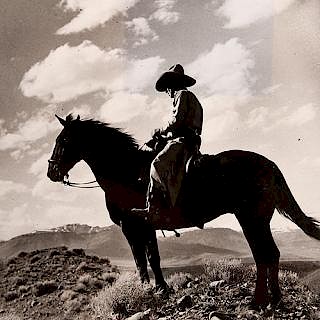Pre and Post-Civil War Photographs of Warren Adams, Including Half Plate Ambrotype by George S. Cook
About Seller
6270 Este Ave.
Cincinnati , OH 45232
United States
With offices in Cincinnati, Cleveland and Denver, Cowan’s holds over 40 auctions each year, with annual sales exceeding $16M. We reach buyers around the globe, and take pride in our reputation for integrity, customer service and great results. A full-service house, Cowan’s Auctions specializes in Am...Read more
Two ways to bid:
- Leave a max absentee bid and the platform will bid on your behalf up to your maximum bid during the live auction.
- Bid live during the auction and your bids will be submitted real-time to the auctioneer.
Bid Increments
| Price | Bid Increment |
|---|---|
| $0 | $25 |
| $500 | $50 |
| $1,000 | $100 |
| $2,000 | $250 |
| $5,000 | $500 |
| $10,000 | $1,000 |
| $20,000 | $2,500 |
| $50,000 | $5,000 |
| $100,000 | $10,000 |
About Auction
Jun 12, 2015 - Jun 13, 2015
Cowan's Auctions dawnie@cowans.com
- Lot Description
Lot of 5, comprised of 4 cased images of Warren Adams taken before and after the Civil War, including: quarter plate daguerreotype of a young Adams, with later penciled identification on tape affixed to cover glass, housed in full thermoplastic Union case; quarter plate daguerreotype of a group of 4 young men including Adams, identified as sitting second from left, housed in full pressed paper case; half plate ambrotype of Adams housed in full leather, push-button case bearing George S. Cook's Charleston studio mark on back. It has been suggested by the family that this portrait was taken during the time that Adams taught French in North Carolina, prior to the Civil War; post-war, sixth plate ambrotype of Adams in civilian clothing, housed in half pressed-paper case. The images are accompanied by a leather Crouch & Fitzgerald document bag, 8.75 x 10.75 in., which was discovered among Adams' belongings and was believed to have been used by him at some point. An inked identification inside the bag indicates that it was later utilized by J.H. Mayne, N.Y.S. RVS.
Lieutenant Colonel Warren Adams
Adams was the son of South Carolina Governor James Hopkins Adams and Jane Margaret Scott Adams. He was born November 28, 1838, in Minervaville, Richland County, SC. He graduated from The Citadel, Military College of South Carolina, in 1859. Adams married Nathalie Heyward, daughter of Senator Nathaniel Heyward, in May 1866, and had nine children, four of whom survived him. Adams was an active participant in several battles in the Civil War, but most notably at Battery Wagner. He was seriously wounded at the Battle of Bentonville, NC, but survived his wounds and returned to Stony Hill Plantation in Kingsville, SC, living there until his death on November 5, 1884. Adams is buried at St. John's Episcopal Church, Congaree, SC.
Adams’ most notable achievement of the Civil War was his command of the 1st South Carolina Infantry Regiment in defense of Battery Wagner at Charleston. He fended off the attacks of the African American 54th Massachusetts Volunteer Infantry led by Colonel Robert Gould Shaw. Attacked twice on July 11 and July 18, 1863, Adams was able to repel the Union forces with only modest losses. Colonel Shaw was killed in the second assault. The fort eventually succumbed to siege when the Confederates abandoned it on the evening of September 6-7, 1863. The Battles of Battery Wagner are the source of the 1989 movie Glory. Adams went on to serve the 2nd South Carolina Cavalry and was shot from his saddle at the Battle of Bentonville in 1865.
The Adams Family of South Carolina:
A collection of photographs and manuscripts concerning one of South Carolina’s oldest and most prominent families. Lots 31-37, 103
The Adams family came to the area near present day Columbia, SC, in the mid-18th century, acquired major land holdings, and became prosperous plantation owners. They were strongly involved in political and military affairs of their state, region, and country, playing major roles in state government as well as the Mexican American and Civil Wars.
James Adams, son of Henry Coker Adams, emigrated from England to Virginia in the early seventeenth century seeking a new life in colonial America. There, he married Agnes Walker and fathered two children before Agnes’ death in 1755. One of the children died early, the other, Joel, survived into adulthood.
Joel Adams was born February 4, 1750, in Culpepper, VA. He was the first of the family to settle in lower Richland County, SC, at Wavering Place in 1768. He married Grace Weston in 1773 and together they bore seven children. Before the American Revolution, Joel began acquiring land along the Congaree River in lower Richland County, accumulating 25,000 acres of plantations in the area. In the Revolutionary War, he was a leader of South Carolina militia forces and served in the Continental Army. He strongly believed in education, and political and military service to one’s state and country. Two of his children were educated at Yale. He died July 8, 1830, in Richland, SC, where he is buried.
One of Joel’s sons, Henry Walker Adams, had the unfortunate situation of losing his wife (Mary Goodwyn) and then dying himself at the early age of 25, leaving behind a son, James Hopkins Adams. Joel raised his grandson until his own death.
James Hopkins Adams was born March 15, 1812, in the Richland District in South Carolina, and died there July 13, 1861. He graduated from Yale in 1831, married Jane Margaret Scott in April 1832, and they had eleven children. He was Brigadier General of Cavalry for the South Carolina Militia and served several terms as a State Representative and State Senator. In 1854, he was elected to be the 66th Governor of South Carolina, serving through 1856. As a member of the “Convention of the People” in 1860-1861, he was a signatory to the South Carolina Ordinance of Secession. Subsequently, Adams served as a Commissioner of South Carolina to the US government to negotiate the transfer of United States property in South Carolina to the state government. He died at Live Oak, his country residence, and is buried in St. John's Episcopal Churchyard in Congaree, SC.
This collection principally concerns one of J. H. Adams children, Warren Adams, (1838–1884) who was a Lieutenant Colonel in the CSA. He was in command of the First South Carolina Infantry Regiment at Battery Wagner, Charleston, SC.
Images and documents related to extended family members, such as 2nd Lieutenant David Adams (KIA in the Mexican American War) and Captain Robert Adams (Charleston Light Dragoons) are also included in the collection.
Provenance:Descended in the Family of Confederate Lt. Colonel Warren AdamsQuarter plate daguerreotype of Adams, with taped identification, housed in thermoplastic case that is completely separated along hinge and is damaged, with loss in lower right corner of cover; tarnish ring around perimeter of image, where plate meets mat. Quarter plate daguerreotype of 4 men, incl. Adams, spotting on plate mostly along perimeter where it meets mat, housed in full case completely separated along hinge. Half plate ambrotype shows heavy spotting on mat, housed in full leather case completely separated along hinge, with significant surface wear to Cook case. Sixth plate ambrotype shows few spots on plate, housed in half case. Leather bag shows some surface wear, especially along edges and corners of bag.Condition
- Shipping Info
-
SHIPPING. At the request of the buyer, Cowan's will authorize the shipment of purchased items. Shipments usually occur within two weeks after payment has been received. Shipment is generally made via UPS Ground service. Unless buyer gives special instructions, the shipping method shall be at the sole discretion of Cowan's Auctions, Inc.. Cowan's is in no way responsible for the acts or omissions of independent handlers, packers or shippers of purchased items or for any loss, damage or delay from the packing or shipping of any property.
-
- Buyer's Premium



 EUR
EUR CAD
CAD AUD
AUD GBP
GBP MXN
MXN HKD
HKD CNY
CNY MYR
MYR SEK
SEK SGD
SGD CHF
CHF THB
THB

















